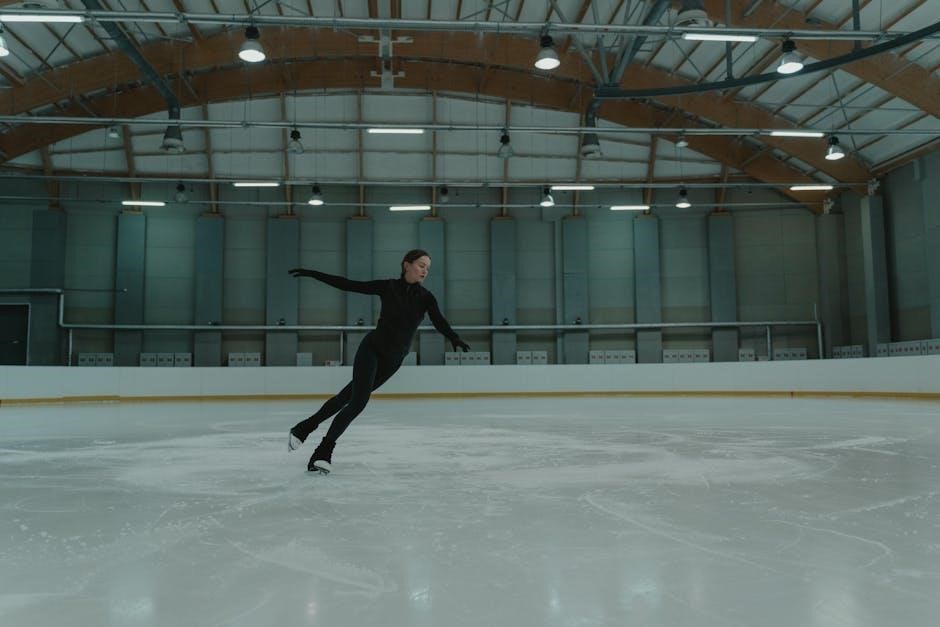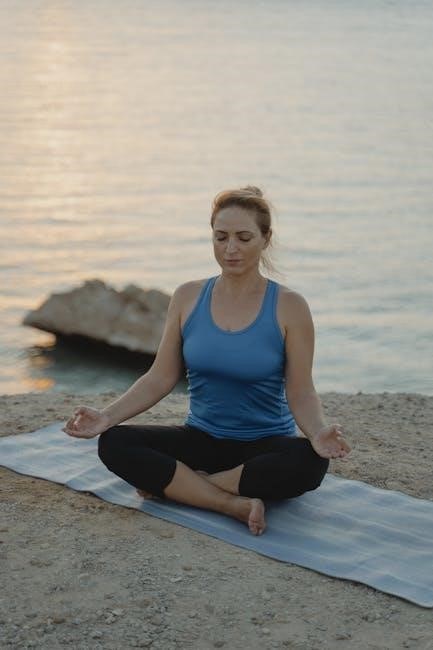The vagus nerve plays a vital role in mental and physical health, influencing anxiety, depression, and trauma recovery. Stanley Rosenberg’s exercises offer practical tools to stimulate it, promoting emotional balance and well-being through simple techniques.

What is the Vagus Nerve?
The vagus nerve is a key cranial nerve regulating heart rate, digestion, and respiratory functions, playing a crucial role in mental health and emotional well-being.
Functions of the Vagus Nerve
The vagus nerve is a complex nerve responsible for regulating various bodily functions; It plays a crucial role in controlling heart rate, aiding digestion, and managing respiratory processes. Additionally, it influences emotional responses and mood regulation. The nerve is deeply connected to the parasympathetic nervous system, which promotes relaxation and reduces stress. It also facilitates communication between the brain and vital organs, such as the gut and lungs. By modulating these processes, the vagus nerve contributes to overall well-being and helps the body recover from stress. Its functions are essential for maintaining balance and health, making it a key focus in therapies aimed at improving mental and physical health.
Structure and Components
The vagus nerve, or cranial nerve X, is a complex nerve with both sensory and motor fibers. It originates in the brainstem, specifically the medulla oblongata, and extends down into the body. The nerve is bilateral, meaning it has branches on both sides of the body. Its structure includes the auricular branch, pharyngeal branch, and esophageal branch, among others. The vagus nerve is the longest cranial nerve, reaching into the abdomen and connecting to organs such as the heart, lungs, and digestive tract. It is composed of thousands of nerve fibers that facilitate communication between the brain and various bodily systems. This intricate structure allows it to play a multifaceted role in both physical and emotional health.
Polyvagal Theory Overview
Polyvagal Theory, developed by Dr. Stephen Porges, explains how the vagus nerve influences emotional regulation and response to safety or danger. It describes three hierarchical responses: the ventral vagal complex for social engagement, the sympathetic nervous system for “fight or flight,” and the dorsal vagal complex for “freeze” reactions. These responses are mediated by the vagus nerve, which adapts to environmental cues to ensure survival. The theory emphasizes the importance of vagal tone in determining emotional resilience and behavioral responses. By understanding these mechanisms, individuals can better manage stress and anxiety, aligning with Stanley Rosenberg’s exercises that aim to enhance vagal function and promote emotional balance.

Importance of Vagus Nerve Stimulation
Vagus nerve stimulation is crucial for enhancing emotional regulation, reducing anxiety, and improving mental health. It promotes relaxation, balances the nervous system, and fosters overall well-being through targeted techniques.
Benefits for Mental Health
Vagus nerve stimulation offers profound benefits for mental health, including reduced anxiety, depression, and trauma symptoms. It enhances emotional resilience, improves mood, and promotes relaxation. By activating the parasympathetic system, it counters stress and fosters calmness. Regular exercises can improve sleep quality, reduce overthinking, and increase self-awareness. The vagus nerve’s role in releasing neurotransmitters like serotonin and dopamine supports mood regulation. These exercises also help individuals manage emotional responses, leading to better coping mechanisms. Over time, consistent practice can rewire the brain, promoting long-term mental well-being and emotional balance. This approach is particularly beneficial for those seeking natural, self-help methods to improve their mental health.
Role in Emotional Regulation
The vagus nerve is central to emotional regulation, enabling the body to respond appropriately to stress and return to a calm state. It facilitates communication between the brain and vital organs, moderating emotional responses. Rosenberg’s exercises target the ventral vagus nerve, enhancing its function to promote emotional balance. By improving vagal tone, individuals can better regulate their emotions, reducing reactivity to stressful situations. This leads to increased emotional resilience and the ability to recover quickly from emotional challenges. The vagus nerve’s role in releasing anti-stress hormones further supports emotional stability. Through targeted exercises, individuals can strengthen their emotional regulation, fostering a more composed and responsive emotional state. This is essential for maintaining mental health and overall well-being.
Impact on the Parasympathetic System
The vagus nerve significantly influences the parasympathetic system, which promotes relaxation and reduces stress. Rosenberg’s exercises enhance vagal tone, strengthening the parasympathetic response. This activation leads to decreased heart rate, lowered blood pressure, and increased feelings of calm. By stimulating the vagus nerve, these practices improve the body’s ability to transition into a relaxed state, countering sympathetic “fight-or-flight” responses. Enhanced parasympathetic activity fosters emotional resilience and reduces chronic stress. Rosenberg’s techniques, such as deep breathing and vocal exercises, directly target the parasympathetic system, creating a balanced nervous system response. This balance is crucial for overall well-being, as it allows the body to recover efficiently from stress and maintain optimal physiological function. The exercises emphasize the vagus nerve’s role in harmonizing the parasympathetic and sympathetic systems for better health outcomes.

Stanley Rosenberg’s Approach
Stanley Rosenberg’s approach focuses on vagus nerve stimulation through breathwork, vocal exercises, and physical postures, offering a holistic method to enhance nervous system balance and promote healing.
Basic Vagus Nerve Exercises
Stanley Rosenberg introduces simple techniques to stimulate the vagus nerve, such as deep breathing exercises, neck stretches, and vocal practices. These exercises aim to enhance vagal tone, promoting relaxation and reducing stress. By incorporating these practices into daily routines, individuals can improve emotional regulation and overall well-being. Rosenberg emphasizes the importance of consistency and gentle movements to activate the nerve effectively. His methods are designed to be accessible, making vagus nerve stimulation achievable for everyone. These foundational exercises lay the groundwork for more advanced techniques, providing a comprehensive approach to nervous system health.
Advanced Breathwork Techniques
Stanley Rosenberg’s advanced breathwork techniques build on foundational practices, offering deeper vagus nerve stimulation. These include alternate nostril breathing, box breathing, and prolonged exhalation exercises. Such methods enhance parasympathetic activation, fostering calm and resilience. Rosenberg also introduces controlled hyperventilation followed by breath-holding to induce profound relaxation. These techniques require focus and precision, making them suitable for those familiar with basic exercises. Regular practice can lead to improved emotional regulation and increased vagal tone, supporting long-term mental and physical well-being. By mastering these advanced breathwork strategies, individuals can achieve a higher level of nervous system balance and overall health.
Vocal and Sound Exercises
Stanley Rosenberg’s vocal and sound exercises are designed to stimulate the vagus nerve through auditory and vibrational feedback. Techniques include humming, chanting, and vowel sound repetitions, which create internal vibrations that activate the nerve. These exercises are particularly effective because the vagus nerve is highly responsive to sound frequencies. By practicing specific vocal patterns, individuals can enhance parasympathetic activity, promoting relaxation and reducing stress. Rosenberg also emphasizes the use of mantra-like phrases to combine breathwork with sound, amplifying the nerve’s response. These exercises are accessible and can be done anywhere, making them a practical tool for daily vagus nerve stimulation and emotional regulation. Regular practice fosters resilience and improves overall nervous system function.
Physical Postures for Stimulation
Physical postures play a key role in Stanley Rosenberg’s approach to vagus nerve stimulation. Specific exercises, such as gentle neck stretches and shoulder stands, are designed to apply subtle pressure to the vagus nerve. These postures target the nerve’s pathway along the cervical spine, enhancing its activation. By incorporating yoga-inspired poses, individuals can improve vagal tone and promote relaxation. Rosenberg emphasizes the importance of holding postures for extended periods to maximize nerve stimulation. These exercises are simple yet effective, requiring minimal equipment and offering profound benefits for both physical and emotional well-being. Regular practice of these postures can lead to improved nervous system regulation and enhanced resilience to stress. They are an essential component of Rosenberg’s holistic approach to vagus nerve health.

Implementing Vagus Nerve Exercises
Stanley Rosenberg’s vagus nerve exercises offer practical tools for daily practice, combining breathwork, vocal techniques, and physical postures to enhance well-being and resilience through regular practice.
Safety Precautions
When implementing Stanley Rosenberg’s vagus nerve exercises, it’s crucial to approach them with care. Start with mild exercises and gradually increase intensity to avoid overstimulation. Ensure you’re in a comfortable environment and free from distractions. If you experience discomfort, dizziness, or pain, stop immediately and consult a healthcare professional. Individuals with severe medical conditions, such as heart problems or epilepsy, should seek medical advice before beginning. Avoid practicing these exercises while driving or operating heavy machinery. Consistency is key, but so is listening to your body to prevent overexertion. By adhering to these precautions, you can safely harness the benefits of vagus nerve stimulation for improved well-being.
Combining with Other Practices
Stanley Rosenberg’s vagus nerve exercises can be effectively combined with other holistic practices to enhance their benefits. For instance, incorporating mindfulness meditation or yoga can deepen relaxation and emotional regulation. Breathwork techniques, such as those used in pranayama, can further stimulate the vagus nerve when paired with Rosenberg’s exercises. Additionally, physical activities like tai chi or walking in nature can complement the practice by promoting overall balance and reducing stress. Combining these methods creates a comprehensive approach to improving mental and physical well-being. However, it’s important to tailor the combination to individual needs and consult a healthcare professional if necessary. This integrative strategy can amplify the positive effects of vagus nerve stimulation, leading to greater resilience and emotional harmony.
Tracking Progress and Adjustments
Tracking progress while practicing Stanley Rosenberg’s vagus nerve exercises involves monitoring changes in symptoms like anxiety, depression, or emotional regulation. Keeping a journal to document daily practices and their effects can provide insights into improvements over time. Adjustments may include modifying exercise frequency, duration, or intensity based on individual responses. Consistency is key, but flexibility allows for tailoring the exercises to suit personal needs. Rosenberg’s guide offers specific techniques to assess and adapt practices, ensuring they remain effective. Regular self-assessment and mindful awareness of physiological and emotional shifts help in fine-tuning the approach. This iterative process supports long-term benefits and enhances the overall impact of vagus nerve stimulation on mental and physical well-being.

The Science Behind the Exercises
Stanley Rosenberg’s exercises leverage the vagus nerve’s role in the parasympathetic system, enhancing heart rate variability and reducing stress hormones like cortisol, promoting emotional and physiological balance.
Neurophysiological Mechanisms
The vagus nerve operates through intricate neurophysiological pathways, connecting the brain to vital organs. Rosenberg’s exercises target the ventral vagus nerve, enhancing its role in safety and social engagement. Stimulation increases parasympathetic activity, reducing stress hormones like cortisol. Neurotransmitters such as GABA and serotonin are modulated, promoting relaxation and emotional balance. The nerve’s fibers regulate heart rate variability, a key indicator of emotional resilience. By activating these pathways, exercises like breathwork and cold exposure strengthen neuroplasticity, rewiring the brain for improved stress responses. This neurophysiological adaptation fosters long-term mental and physical well-being, supported by scientific studies on vagal tone and its impact on health.

Impact on the Nervous System
Stanley Rosenberg’s vagus nerve exercises significantly influence the nervous system by enhancing parasympathetic dominance, reducing sympathetic overactivity. This shift promotes relaxation, lowers stress responses, and improves emotional regulation. The ventral vagus nerve, responsible for social engagement and safety, is particularly activated, fostering resilience against trauma. Regular stimulation strengthens the nervous system’s ability to adapt to stress, enhancing heart rate variability and reducing inflammation. These exercises also modulate the release of neurotransmitters, such as acetylcholine, which supports cognitive function and calmness. Over time, consistent practice can rewire the nervous system, leading to improved mental clarity, emotional stability, and overall well-being. The exercises’ impact on the nervous system is foundational for long-term health and vitality.

Longitudinal Studies and Evidence
Longitudinal studies on Stanley Rosenberg’s vagus nerve exercises demonstrate consistent positive outcomes in reducing anxiety, depression, and trauma symptoms. Research highlights improved heart rate variability and enhanced parasympathetic function. Participants showed increased emotional regulation and resilience over time. These studies support the efficacy of Rosenberg’s techniques in promoting long-term nervous system balance and overall well-being. The evidence underscores the exercises’ potential as a sustainable, non-invasive approach to mental health. Regular practice correlates with significant improvements in both emotional stability and physical health, making these exercises a valuable tool for holistic wellness. The longitudinal data reinforces the transformative impact of vagus nerve stimulation on the nervous system and daily functioning. This body of research provides a strong foundation for incorporating these exercises into mental health practices.

Benefits of Vagus Nerve Stimulation
Longitudinal studies confirm the lasting benefits of vagus nerve stimulation, showing reduced anxiety, depression, and trauma symptoms. Improved heart rate variability and emotional regulation are documented. Research supports the efficacy of Stanley Rosenberg’s exercises in enhancing parasympathetic function and promoting nervous system balance. These studies provide robust evidence for the exercises’ ability to foster long-term mental and physical well-being. The data highlights sustainable results, making vagus nerve stimulation a valuable, non-invasive approach for holistic health.
Mental Health Improvements
Vagus nerve stimulation, as outlined in Stanley Rosenberg’s exercises, significantly improves mental health by reducing anxiety, depression, and trauma symptoms. By enhancing parasympathetic activity, it promotes emotional resilience and calms the nervous system. Regular practice of Rosenberg’s techniques, such as breathwork and vocal exercises, has been shown to lower stress hormones and improve mood regulation. Individuals with anxiety experience reduced panic episodes, while those with depression often report increased feelings of calm and well-being. The exercises also support trauma recovery by re-establishing a sense of safety and emotional balance. Overall, vagus nerve stimulation offers a natural, non-invasive approach to mental health improvement, making it a valuable tool for long-term emotional and psychological well-being.
Physical Health Enhancements
Stanley Rosenberg’s vagus nerve exercises contribute to significant physical health improvements by enhancing the body’s autonomic functions. These exercises strengthen the parasympathetic nervous system, promoting better heart rate regulation and reducing inflammation. Improved vagal tone supports digestion, reducing symptoms of irritable bowel syndrome and enhancing nutrient absorption. Additionally, vagus nerve stimulation boosts immune function by activating anti-inflammatory pathways, which can aid in recovery from chronic illnesses. Rosenberg’s techniques also improve sleep quality, which is crucial for overall physical restoration. By addressing the root of physiological imbalances, these exercises provide a holistic approach to improving both acute and chronic health conditions, making them a valuable complement to traditional medical treatments.
Neuroplasticity and Adaptation
Stanley Rosenberg’s exercises enhance neuroplasticity by promoting adaptive changes in the brain and nervous system. By consistently stimulating the vagus nerve, individuals can strengthen neural pathways associated with emotional regulation and resilience. This process fosters a more responsive and adaptable nervous system, enabling better coping mechanisms for stress and trauma. Over time, these exercises encourage the growth of new neural connections, improving communication between the brain and body. Such adaptations lead to increased emotional and physiological flexibility, allowing individuals to navigate challenges with greater ease. Rosenberg’s techniques thus offer a powerful way to rewire the brain and enhance overall nervous system function through targeted vagus nerve stimulation.

Resources and Further Reading
Stanley Rosenberg’s book, Accessing the Healing Power of the Vagus Nerve, offers comprehensive exercises and techniques; Additional guides, eBooks, and tools are available in PDF, ePub, and MOBI formats.
Stanley Rosenberg’s Book
Accessing the Healing Power of the Vagus Nerve by Stanley Rosenberg is a groundbreaking guide offering self-help exercises for anxiety, depression, trauma, and autism. The book provides practical tools to stimulate the vagus nerve, enhancing emotional regulation and mental well-being. Rosenberg’s approach emphasizes breathwork, vocal exercises, and physical postures to optimize nervous system function. Available in formats like PDF and eBook, this resource is accessible to anyone seeking to understand and apply vagus nerve techniques. It has become a vital reference for those exploring neuroplasticity and holistic healing, making it a must-read for both professionals and individuals seeking natural healing methods.
Additional Materials and Guides
Beyond Stanley Rosenberg’s book, additional materials like eBooks, articles, and online courses provide deeper insights into vagus nerve stimulation. These resources often include practical exercises, step-by-step guides, and case studies. They cater to both beginners and advanced practitioners, offering comprehensive tools for mental and physical well-being. Many guides focus on specific techniques, such as breathwork, vocal exercises, and physical postures, while others explore the intersection of polyvagal theory and daily life. These materials are widely accessible in formats like PDF and digital downloads, making it easy for individuals to incorporate vagus nerve exercises into their routines. They serve as valuable complements to Rosenberg’s work, enhancing understanding and application of vagus nerve stimulation techniques.
Recommended Tools and Devices
To enhance vagus nerve stimulation, various tools and devices can be used alongside Stanley Rosenberg’s exercises. Heart rate variability (HRV) monitors are popular for tracking progress, as they measure the nervous system’s response to stimulation. Breathing apps and biofeedback devices also provide real-time feedback, helping users optimize their techniques. Additionally, yoga mats, resistance bands, and mindfulness apps can support physical postures and breathwork. Some devices, like transcutaneous vagus nerve stimulators (tVNS), offer gentle electrical stimulation for enhanced effects. These tools complement Rosenberg’s methods, offering a holistic approach to improving vagal tone and overall well-being. By incorporating these resources, individuals can deepen their practice and achieve better results in mental and physical health.



